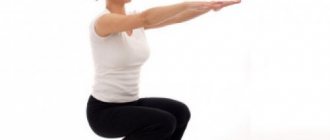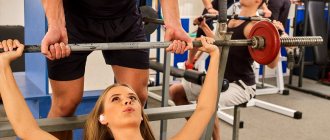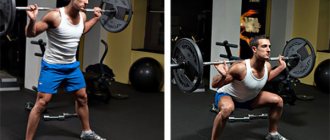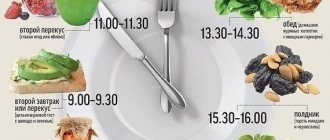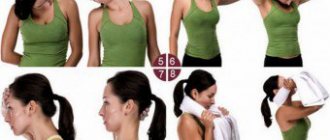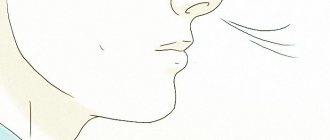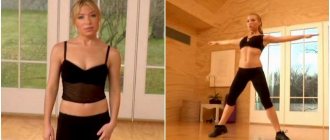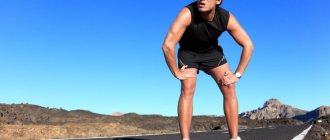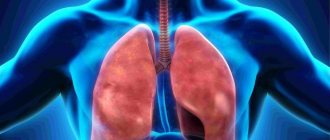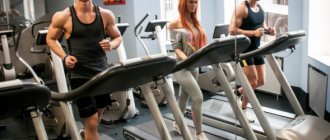In Sergei Bubnovsky’s book “50 Essential Exercises for Health,” these exercises are suggested for people with hypertension and other diseases of the cardiovascular system to normalize blood circulation. However, each exercise has a lot of “side effects” - from strengthening the abdominal muscles, arms and legs to the prevention of herniated intervertebral discs and osteochondrosis. Perhaps this is the kind of gymnastics that should be included in your daily set of exercises first.
Kneeling push-ups
The work of the muscles of the thoracic spine and the girdle of the upper limbs normalizes the work of the pulmonary and systemic circulation. And the diaphragmatic exhalation “Ha-a” while extending the arms allows you to reduce intrathoracic, intracranial and intra-abdominal pressure. It has no contraindications.
I.P. Lying on the floor, rest on your knees, arms bent at the elbows. As you exhale “Ha-a,” we straighten our arms and keep our body straight.
Weakened patients (as I call only patients with chronic ischemic heart disease - HIHD) can start by doing push-ups on a bench while kneeling. The pause between push-ups is 30–45 seconds for the weak, 10–20 seconds for the relatively healthy. Take your time to increase the total number of push-ups, starting with 5-10 repetitions in two or three sets. Aim for 100 push-ups in one session (10 sets of 10 push-ups).
Squats
This exercise is basic for the leg muscles, the condition of which, as is known, depends on the condition of the vessels of the lower extremities. Thanks to the regular work of these muscles, the speed and volume of blood flow in the systemic circulation is restored, and the return of venous blood from the legs to the heart is improved. Contraindications: deforming arthrosis in the hip and knee joints.
I.P. Standing facing a fixed support, to which the rubber shock absorber is fixed, at such a distance that the shock absorber is tensioned. Feet shoulder width apart. The back and arms are straight, holding the bar at chest level. Try to squat at least 90 degrees (thigh to floor) for the first 10–20 movements, bending your leg at the knee joints, keeping your back straight.
Extend your legs while exhaling “Ha-a.” Perform at least 10 repetitions per set. Try to gradually increase the number of approaches. But do it slowly, for example, add one approach every 2-3 weeks.
Push-ups and squats are strength exercises that help restore the speed and volume of blood flow, but in order for the vessels to be ready to regularly pass the necessary volumes of blood through themselves, aerobic exercise is needed. These include, for example, fast walking.
The essence of the Bubnovsky method
Sergei Mikhailovich Bubnovsky developed a program for the treatment of hypertension without the use of drugs
First, a few words about who Dr. Bubnovsky is.
Sergei Mikhailovich Bubnovsky kinesiotherapist, professor, doctor of medical sciences, author of books and creator of medical centers for the treatment of diseases of the spine and joints, or rather their restoration, without the use of operations and painkillers. Everything new is well forgotten old. The foundations of kinesiology and kinesiotherapy come from Ancient Greece and Ancient Rome. Long before our era, they knew methods of relieving pain using special exercises for various muscle groups and hydromassage techniques. In ancient China, many diseases were treated with correct movements and breathing exercises.
Until the 17-18th century, these developments were consigned to oblivion, especially in European countries. The renewed interest in them concerned mainly rehabilitation with the help of movements for diseases of the musculoskeletal system.
Method S.M. Bubnovsky has been patented, his books have been translated into many languages of the world, his numerous students are developing the direction of rehabilitation not only for diseases of the musculoskeletal system, but also for somatic and internal diseases.
The essence of Bubnovsky’s method is that by working out his body on simulators or performing physical complexes even in volumes that are negligibly small in relation to normal loads, a patient who has pathological impulses from diseased organs (heart, blood vessels, lungs), which prevents him from performing healthy loads, does not only loses fear of movement. This triggers the mechanisms of self-regulation and self-healing, which is an anti-stress effect. All systems and subsystems of the body are included in the movement, their work is synchronized.
Blood flow in the diseased organ gradually improves, muscle activity helps the heart pump more blood, and this in turn allows you to expand the load and restore the body. In this way, the postulate is realized that muscle tissue is the healing tissue of the body.
Walking (walk)
It is better to practice walking in the park, on dirt paths (if on asphalt, then shoes should have good soles - sneakers, for example). If this is not possible - for example, in winter when there is ice - then you can walk at home. This will require a step or step. Walk for at least 20 minutes, monitoring your pulse - heart rate (HR). A level of 140–145 beats per minute is safe for the cardiovascular system.
Gradually increase the speed and number of meters (kilometers). A good figure is 3–5 km 2–3 times a week. If you walk at home - 20-25 minutes at a pulse of 140-145 beats per minute 2-3 times a week.
Press forward
The exercise replaces push-ups and is suitable for anyone, even physically weak and/or elderly people. Refers to strength exercises. It is also useful for COPD. It has no contraindications.
I.P. Sitting with your back to the machine, rest your back on the fitball. While exhaling “Ha-a”, perform a forward press of weights fixed to the lower blocks of the machine.
There is no need to rush to increase the weight and number of episodes. Monitor your heart rate response to exercise. It should not exceed 140–145 beats per minute after completing the exercise.
Main advantages
https://youtu.be/h3gKeMQ2jdQ
Almost any pharmacological drug is a xenobiotic and has a number of contraindications and side effects. Figuratively speaking, by treating one thing, a person cripples another. In the conditions of modern ecology and growing chronic stress, including man-made, taking a large number of medications also becomes stressful and creates additional stress on the liver.
Unfortunately, today it is not possible to completely abandon drug therapy, but by taking alternative, natural methods of restoring health, the patient protects himself from the negative effects of pharmacotherapy. Drug-induced disease claims 100,000 lives every year.
Treatment options for hypertension using the Bubnovsky method allow:
- Over time, limit or stop taking medications;
- reduce stress;
- restore impaired blood flow;
- eliminate pathology of intervertebral discs;
- strengthen your back muscles;
- increase psycho-emotional background;
- increase physical activity;
- protect the liver from having to metabolize medications;
- extend active longevity.
Another advantage is that your “pharmacy” (your muscles) is always with you and there is no need to spend money on expensive medications.
Half birch
The effect of this exercise is hidden in the anti-gravity effect on the vessels of the brain (legs above the head), which helps improve blood supply to these vessels. Exhalation “Ha-a” relieves intrathoracic, intra-abdominal and intracranial pressure. It has no contraindications.
I.P. on the floor, head to the counter, hands resting on the base of the machine. Raise your legs to a 90-degree angle above the floor so that your lower back lies on the floor. Feeling the tension in the back surface of the muscles in the legs, we slightly lift the pelvis off the floor, but do not stand on our shoulder blades.
It is important to select a weight at which you can comfortably, without much strain, perform at least 20 repetitions in one series.
In this version, the exercise is safe even with high blood pressure and allows you to fight not only blood pressure, but also osteochondrosis of the lumbar spine.
Execution technique
It is very important to follow proper breathing techniques during squats, because otherwise the body simply will not be able to receive the amount of oxygen it needs and will not cope 100% with the load that you place on it. All this leads to insufficient effectiveness of exercises.
With classic squats
To become familiar with breathing techniques when performing exercises, you should start with classic squats without using a barbell or dumbbells. All you need is your own weight and desire:
- Exhale deeply, clearing your lungs of carbon dioxide.
- Smoothly lower yourself down, pursing your lips tightly. Inhale air slowly through your nose.
- Take your time.
- When your pelvis is level with your knees, stop inhaling.
- At this time you need to start exhaling.
- Rise up, exhaling air.
- You can finish exhaling by raising your body not all the way, but only halfway.
While performing a squat, extend your arms in front of you or raise them to your shoulders so as not to interfere with the expansion of your chest.
With a barbell
Using a barbell when performing squats allows you to pump up the muscles of your thighs and buttocks even more, and also develops your abs and lumbar region. Having mastered regular squats with your own weight, you can begin squats with weights, for example, with a barbell.
Technique:
- Take a deep breath and exhale sharply, and then approach the barbell.
- Place the barbell on your shoulders.
- At the same time, spread your legs and straighten your back.
- Fill your lungs ¾ full with air, and then slowly lower to the desired level.
- At the lowest point you can hold your breath for a second.
- Lifting with a barbell requires effort, so when returning to the starting position, take your time to exhale.
- Having fully straightened up, you need to sharply exhale all the remaining carbon dioxide and fill your lungs with oxygen again.
According to Bubnovsky
A special feature of Dr. Sergei Bubnovsky’s technique is exhalation of air from the lungs in a rather unusual way. When lifting your body from a lower position, you need to contract your diaphragm and exhale, saying “haaa,” pushing out all the carbon dioxide from your lungs. Please note that the sound should be sharp and powerful. This special squatting technique will help you strengthen your back and leg muscles, and at the same time improve your cardiovascular health.
Press
A wonderful exercise from a series of power aerobics that helps get rid of abdominal fat, restores the anatomical bed of internal organs and relieves pain in the lumbar spine due to herniated intervertebral discs. It has no contraindications.
I.P. Lying on your back, with your feet towards the counter, with your hands holding on to any fixed support (for example, a wall bars). The legs are fixed to the upper block of the exercise machine. As you exhale “Haa,” we pull our knees towards our stomach. We do 19-20 repetitions daily.
Alternatively, you can do it without weights. That is, the legs rise due to the strength of the abdominal muscles.
